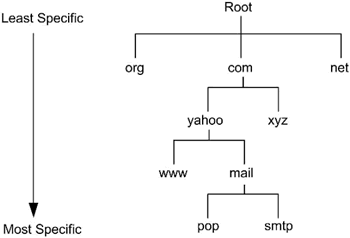Domain Name Space
Host names are divided into several pieces called domains. Domains are designed in a hierarchical structure. The top-level domains refer to the type of organization to which the network belongs, and subdomains further identify the specific network on which the host is situated.
The domain name space is also a hierarchical tree structure, as shown in Figure below.

While searching for a host, the DNS tree is traversed in an ascending order, starting from leaf nodes and moving towards the root. Therefore, the nodes falling on the left side are more specific in contrast to the nodes on the right side. For example, node abc in www.abc.com is more specific than the com node.
In a Fully Qualified Domain Name (FQDN), the host name is specified by the leftmost label. The next label to the right defines the local domain to which the host belongs. The local domain also can be a part of or a sub-domain of another domain. Therefore, naming gets less specific while moving from the left to the right. This process is followed until the root of the tree is reached.
The dot (.), which is the root domain, is the starting point of the tree. In DNS, records are specified as the last character in the domain name. A domain is a portion in a domain name space. Consider the following example:
There are four domain names:
- abc.com
- abc.net
- xyz.com
- pqr.org
In these domain names, there are only seven domains involved. These seven domains are listed here:
- abc
- abc
- xyz
- pqr
- com
- net
- org
A Top-Level Domain (TLD) is a domain that directly branches off from the root of the tree. com, net, and org were the top-level domains in the preceding example. A subdomain is a child domain that comes lower in the DNS hierarchy tree. For example, here are three domain names:
- www.abc.com
- pop.abc.com
- somethingelse.abc.com
In these three domain names, www, pop, and somethingelse are the subdomains of the com domain. Therefore, it can be concluded that all domains-except the root domain-are subdomains of other domains.
A DNS master name server is a computer that maintains a database of host names and IP addresses for one or more zones. It is advisable to have DNS slave name servers that can be synchronized with the master name server to act as backup name servers in case the primary server fails.
While performing the function of inverse resolution, mapping an IP address to its host name, the DNS moves from the left node toward the right node to deduce the IP address. In contrast to the host name, the dot (.) notation of an IP address becomes more specific while moving to the right. Therefore, the IP addresses in the DNS are represented in reverse order to handle this situation. The Top-Level Domain (TLD) for IP addresses is the in-addr.arpa domain. This technique helps in simplifying the process of inverse resolution that now works as a forward resolution process in which the DNS host name finds the corresponding IP addresses.
In this tutorial:
- Linux Other Network Servers
- Setting the FTP User Account
- Configurations File for FTP Server
- ftpusers
- Anonymous FTP
- Using Proper Password and Group Files
- Anonymous FTP Warnings
- Sendmail
- Sendmail Security
- Domain Name Service
- Domain Name Space
- Services Offered By a DNS Server
- DNS Transactions
- BIND
- BIND Configuration
- Resource Records (RR)
- Start of Authority (SOA)
- nslookup
- BIND Security
- Host Name Spoofing
- Running BIND with Least Privileges
- DNS Security Extensions (DNSEC)
- SAMBA
- SMB Protocol
- Mounting the SMB File System
- SAMBA Security
- Server-Level Security
